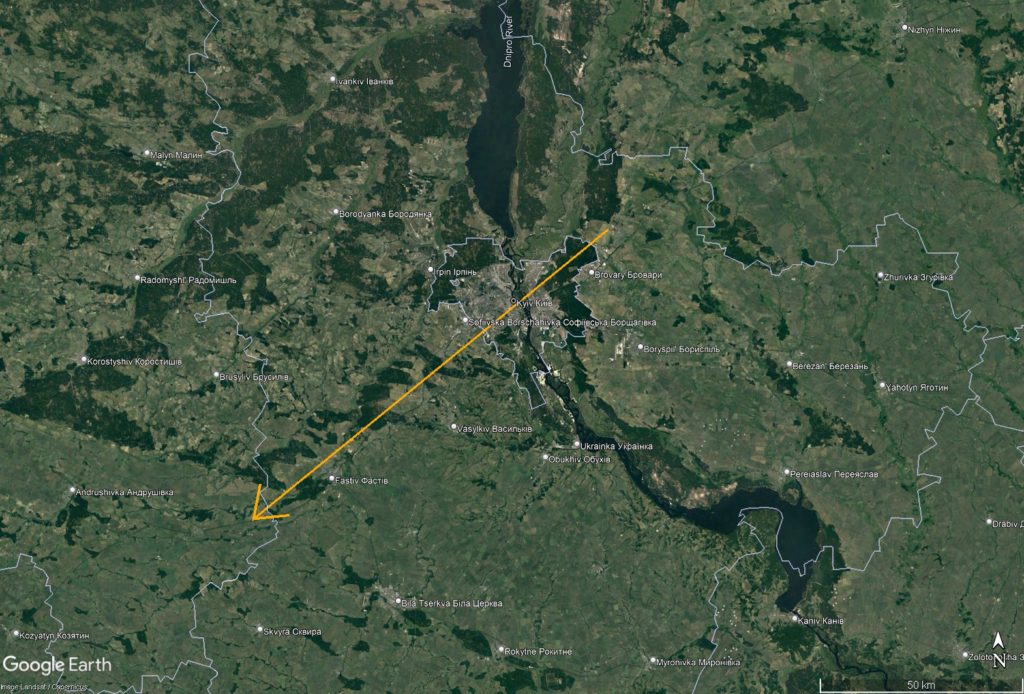As reported by the media around the world, the citizens of the Ukrainian capital Kyiv, which is under occasional attacks by Russian rockets, were frightened by a bright flash on the sky in the evening of April 19, 2023 (Event #2223-2023). Although it was not immediately clear, the flash was a purely natural phenomenon this time, namely a very bright bolide. A part of the bolide, which started at 18:57:20 UT and lasted for 5 seconds, was recorded from a large distance by the easternmost cameras of the European Fireball Network (EN). EN is a project of the Astronomical Institute of the Czech Academy of Sciences operated in Slovakia in collaboration with the Astronomical Institute of the Slovak Academy of Sciences. The most valuable are the records by supplementary video cameras in Kolonica and Stará Lesná, and radiometric light curves, especially from Kolonica. An all-sky image was obtained at Kolonica as well, though the sky was partly cloudy there and the bolide appeared only in gaps close to the horizon.
Last night, Kyiv residents observed a strange, unusual, bright flash in the sky. The flash was also observed even from the territory of Belarus. One of the dominant versions now is that it was the fall of some kind of space object to Earth: meteor, satellite, space debris pic.twitter.com/N511Sr2iM1
— Special Kherson Cat 🐈🇺🇦 (@bayraktar_1love) April 20, 2023
There are also several casual video records of the fireball from Kyiv. The best one was obtained near the River Mall (see above and on Twitter) and shows the middle and end part of the bolide. That video was approximately calibrated by us using Google Earth imagery. Finally, the beginning of the bolide was captured by the camera located in Bárdos Lajos Primary School in Fehérgyarmat, Hungary, belonging to the private AllSky7 project and operated by Krisztián Sárneczky and Zoltán Pásztor. The video was kindly provided for analysis by Mike Hankey.
Despite poor geometric condition (the distances of the Slovakian and Hungarian cameras to the bolide were 570 – 780 km and the Kyiv video contained only one star), the trajectory of the bolide was determined with the uncertainty of only few hundreds of meters. The bolide was first observed at the height of 98 km above Velyka Dymerka. It then passed directly above Kyiv at the heights of around 80 km and continued to the southwest with the speed of 29 km/s. A big flare occurred at the height of 38 km, when the bolide absolute magnitude reached –18 or slightly more, meaning that the bolide belonged to the superbolide category (bolides brighter than magnitude – 17). The meteoroid of an estimated initial mass of 200 – 300 kg (diameter of about half meter) disrupted at 38 km into many fragments and dust. The deceleration of the bolide after the flare suggests that the largest produced fragments had masses below 1 kg. Nevertheless, another similarly bright flare occurred at the height of 32.5 km and other smaller flares followed at 31, 30, and 29.5 km. The bolide was last seen on the video at the height of 28 km when its speed was about 10 km/s. The ground projection of the trajectory is plotted in Figure 1. The length of the trajectory was 132 km and the average slope to the horizontal was 32 degrees.

The large initial speed was not favorable for meteorite survival. Indeed, the profiles of the flares suggest that only small meteorites could reach the ground. Depending on their sizes and actual high-altitude winds, they may be located somewhere between the cities Popil’nya, Romanivka, Strokiv, and Pavoloch. In fact, the meteoroid was rather strong, since the maximum dynamic pressure during the flight reached 5 MPa. Under more favorable conditions, the meteorite production could be higher.
The heliocentric orbit was asteroidal but with remarkably high inclination to the ecliptic of 46.5 degrees. With the semimajor axis of 1.59 AU, the orbital period was close to two years, suggesting that the meteoroid may have passed close to the Earth two years ago. The perihelion distance was 0.95 AU.
We thank Mike Hankey for providing the video record from Fehérgyarmat and Ján Svoreň who is supporting the Slovak part of the EN.
Jiří Borovička and Pavel Spurný (Astronomical Institute of the Czech Academy of Sciences, Ondřejov)




 You saw something bright and fast? Like a huge shooting star? Report it: it may be a fireball.
You saw something bright and fast? Like a huge shooting star? Report it: it may be a fireball.  You counted meteors last night? Share your results with us!
You counted meteors last night? Share your results with us!  You took a photo of a meteor or fireball? You have a screenshot of your cam? Share it with us!
You took a photo of a meteor or fireball? You have a screenshot of your cam? Share it with us!  You caught a meteor or fireball on video? Share your video with us!
You caught a meteor or fireball on video? Share your video with us!
2 comments
Good afternoon Thank you very much for your work, calculation and description of the fireball seen over Kiev on April 19th. Thanks for your help and support. According to the preliminary calculations that were at our disposal, we began a search expedition, surveyed the fields and interviewed local residents in the area of the city of Fastov. We used aerial reconnaissance and ground search activities. So far the result is negative. If you have more details please let us know.
Thank you for your help and support for Ukraine!
Thank you, have a nice day!
Sincerely, Head of the Ukrainian Space Society
Andrey Gorin.
Dear Andrii, the fireball indeed passed near Fastiv but continued further southwest. I would recommend to search nearly in the middle between Parypsy and Savertsi villages, where ~20 g meteorites could be located. Jiří